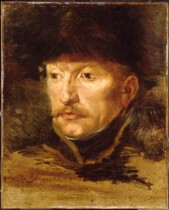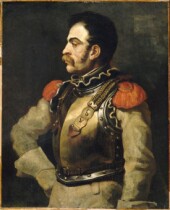Heads of Torture Victims (study for The Raft of the Medusa)
Gericault's Guillotined Heads presents a gruesome depiction of death and decay. The female head on the left has pallid white skin and closed eyes, while the male head is depicted with its mouth and eyes open, staring vacantly past the viewer. The jagged, rough marks on the neck reveal the brutal and painful death. These figures suffered at the guillotine. Here Gericault shows his brilliant mastery of chiaroscuro, seen in the contrasts of dark and light throughout the composition. The loose brushstrokes used to render both the faces and the cloth add to the work's dramatic appeal.
Severed limbs and body parts are the most striking subject in Géricault's oeuvre. The five works he created in this style are considered to be studies for the figures he would render in his most famous work, The Raft of the Medusa (1818-1819). Always striving for authenticity, the artist kept dead body parts of victims of the guillotine in his studio. Gériault's use of horrific subject matter was first and foremost an artistic means of pushing the boundaries, but also the vehicle of a political message. By so clearly depicting the savagery involved in the use of the guillotine and presenting it in such a direct and confrontational way, Géricault is visually speaking out against this brutal form of punishment, which had been used widely during the Bourbon Restoration.
















.jpg)